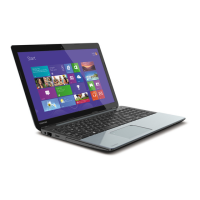
Do you have a question about the Toshiba Satellite S50-C Series and is the answer not in the manual?
| Bluetooth | Bluetooth 4.0 |
|---|---|
| Processor | Intel Core i5 or i7 (depending on model) |
| RAM | Up to 16GB DDR3L 1600MHz |
| Storage | 256GB SSD |
| Display | 15.6-inch Full HD (1920x1080) LED-backlit display |
| Graphics | integrated Intel HD Graphics (depending on model) |
| Operating System | Windows 10 |
| Weight | Approx. 2.2 kg (4.85 lbs) |
| Optical Drive | DVD SuperMulti drive |
| Wireless | Wi-Fi 802.11ac |
| Ports | HDMI, Ethernet, Headphone/Microphone combo jack, SD card reader |
| Webcam | HD Webcam |
Provides instructions on protecting stored data and Toshiba's liability limitations for data loss.
States the computer is not designed for critical applications and disclaims liability for such use.
Provides initial tips for using the computer and connecting components.
Guides on initial computer setup, including cooling fan information and component additions.
Instructions on connecting the computer to AC power and understanding power indicators.
Explains the procedure for charging the main battery for initial computer use.
Provides step-by-step instructions on how to properly shut down the computer.
Explains the process for restarting the computer and its operating system.
Details how to put the computer into Sleep mode to conserve power and resume later.
Outlines options for recovering the internal storage drive using built-in utilities.
Provides instructions on creating a recovery drive, recommended before system use.
Explains how to restore the system from a previously created recovery drive.
Guides on resetting the PC, with options to keep or remove personal files.
Details on reinstalling bundled drivers and applications using the TOSHIBA Application Installer.
Explains how to use the touchpad for navigation, selection, and scrolling.
Provides tips for adjusting touchpad sensitivity and avoiding accidental input.
Explains how to choose display modes (PC only, duplicate, extend, second screen).
Details on keyboard layout, special keys, and basic usage for efficient typing.
Explains how to use the touch screen for interacting with icons, buttons, and menus.
Guides on accessing and changing pointing device or mouse settings.
Emphasizes the importance of frequently saving work to prevent data loss.
Details methods for backing up files and the entire computer to protect against data loss.
Explains how the computer operates on battery power and its energy-saving design.











